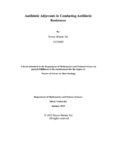| dc.contributor.advisor | Naser, Iftekhar Bin | |
| dc.contributor.author | Tui, Nazoa Shimin | |
| dc.date.accessioned | 2024-04-21T09:55:35Z | |
| dc.date.available | 2024-04-21T09:55:35Z | |
| dc.date.copyright | ©2023 | |
| dc.date.issued | 2023-01 | |
| dc.identifier.other | ID: 18276005 | |
| dc.identifier.uri | http://hdl.handle.net/10361/22639 | |
| dc.description | This thesis report is submitted in partial fulfillment of the requirement for the degree of Master of Science in Biotechnology, 2023. | en_US |
| dc.description | Cataloged from PDF version of thesis. | |
| dc.description | Includes bibliographical references (pages 23-32). | |
| dc.description.abstract | Antimicrobial resistance (AMR) has now become one of the significant global health challenges and are not limited to natural antibiotics but also for synthetic antibiotics. Therefore, it is crucial to search for more effective antibiotics and develop novel chemical entities with new mechanisms of action. But the process is challenging and expensive. Antibiotics adjuvants gives us hope in combat with AMR. This prosperous and successful strategy in combating antibiotic resistance will be the focus of this review. Genotypic antibiotic resistance or intrinsic resistance occurs predominantly by three mechanisms (i) inactivation of the antibiotic (i.a) enzymatic modification (i.b) enzymatic breakdown, (ii) decreased antibiotic uptake or accumulation within the bacterial cell by increased efflux, (iii) modification of the antibiotic target site resulting reduced affinity. Therefore, proteins or enzymes involved in these resistance mechanisms are potential targets for developing adjuvant drugs. Another approach is enhancing host cell responses using therapeutic for pathogen eradication. Current research with broad-spectrum antibiotic adjuvants and hybrids approach for antibiotic-adjuvant also being studied. However, there is a race between humans and microorganisms for developing new drugs with antibiotic activity versus acquiring resistance mechanisms. In the current study, several approaches to adjuvants have been discussed, from the well-known and clinically validated approach of inhibiting β-lactamase enzymes and efflux pumps to more indirect approaches, such as inhibiting bacterial signaling and response systems that mediate AMR. Adjuvants that act by increasing cellular uptake of antibiotics, adjuvants that inhibit modification of the antibiotic or its target, and finally, the identification of adjuvants that act upon less obvious targets, such as non-essential steps in bacterial cell wall synthesis, are also discussed. | en_US |
| dc.description.statementofresponsibility | Nazoa Shimin Tui | |
| dc.format.extent | 43 pages | |
| dc.language.iso | en | en_US |
| dc.publisher | Brac University | en_US |
| dc.rights | Brac University theses are protected by copyright. They may be viewed from this source for any purpose, but reproduction or distribution in any format is prohibited without written permission. | |
| dc.subject | Antimicrobial resistance | en_US |
| dc.subject | Synthetic antibiotics | en_US |
| dc.subject | AMR | en_US |
| dc.subject | Antibiotics | en_US |
| dc.subject.lcsh | Antibiotics | |
| dc.subject.lcsh | Anti-infective agents | |
| dc.title | Antibiotic adjuvants in combating antibiotic resistance | en_US |
| dc.type | Thesis | en_US |
| dc.contributor.department | Department of Mathematics and Natural Sciences, Brac University | |
| dc.description.degree | M. Biotechnology | |

